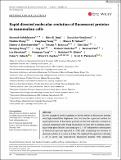Rapid directed molecular evolution of fluorescent proteins in mammalian cells
Author(s)
Babakhanova, Siranush; Jung, Erica E; Namikawa, Kazuhiko; Zhang, Hanbin; Wang, Yangdong; Subach, Oksana M; Korzhenevskiy, Dmitry A; Rakitina, Tatiana V; Xiao, Xian; Wang, Wenjing; Shi, Jing; Drobizhev, Mikhail; Park, Demian; Eisenhard, Lea; Tang, Hongyun; Köster, Reinhard W; Subach, Fedor V; Boyden, Edward S; Piatkevich, Kiryl D; ... Show more Show less
DownloadPublished version (4.404Mb)
Publisher with Creative Commons License
Publisher with Creative Commons License
Creative Commons Attribution
Terms of use
Metadata
Show full item recordAbstract
In vivo imaging of model organisms is heavily reliant on fluorescent proteins with high intracellular brightness. Here we describe a practical method for rapid optimization of fluorescent proteins via directed molecular evolution in cultured mammalian cells. Using this method, we were able to perform screening of large gene libraries containing up to 2 × 107 independent random genes of fluorescent proteins expressed in HEK cells, completing one iteration of directed evolution in a course of 8 days. We employed this approach to develop a set of green and near-infrared fluorescent proteins with enhanced intracellular brightness. The developed near-infrared fluorescent proteins demonstrated high performance for fluorescent labeling of neurons in culture and in vivo in model organisms such as Caenorhabditis elegans, Drosophila, zebrafish, and mice. Spectral properties of the optimized near-infrared fluorescent proteins enabled crosstalk-free multicolor imaging in combination with common green and red fluorescent proteins, as well as dual-color near-infrared fluorescence imaging. The described method has a great potential to be adopted by protein engineers due to its simplicity and practicality. We also believe that the new enhanced fluorescent proteins will find wide application for in vivo multicolor imaging of small model organisms.
Date issued
2022Department
Massachusetts Institute of Technology. Department of Brain and Cognitive SciencesJournal
Protein Science
Publisher
Wiley
Citation
Babakhanova, Siranush, Jung, Erica E, Namikawa, Kazuhiko, Zhang, Hanbin, Wang, Yangdong et al. 2022. "Rapid directed molecular evolution of fluorescent proteins in mammalian cells." Protein Science, 31 (3).
Version: Final published version